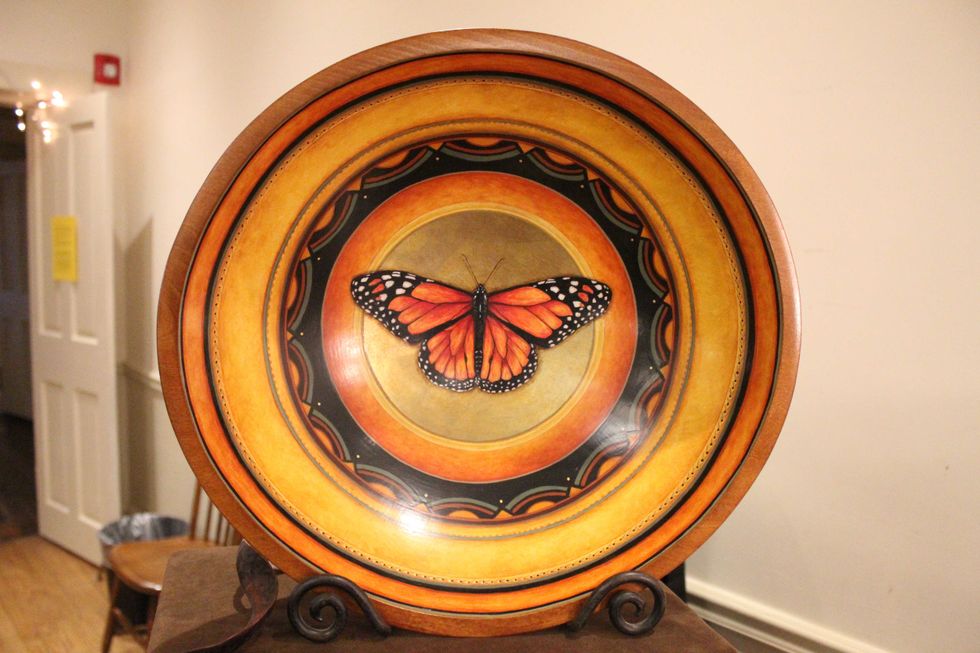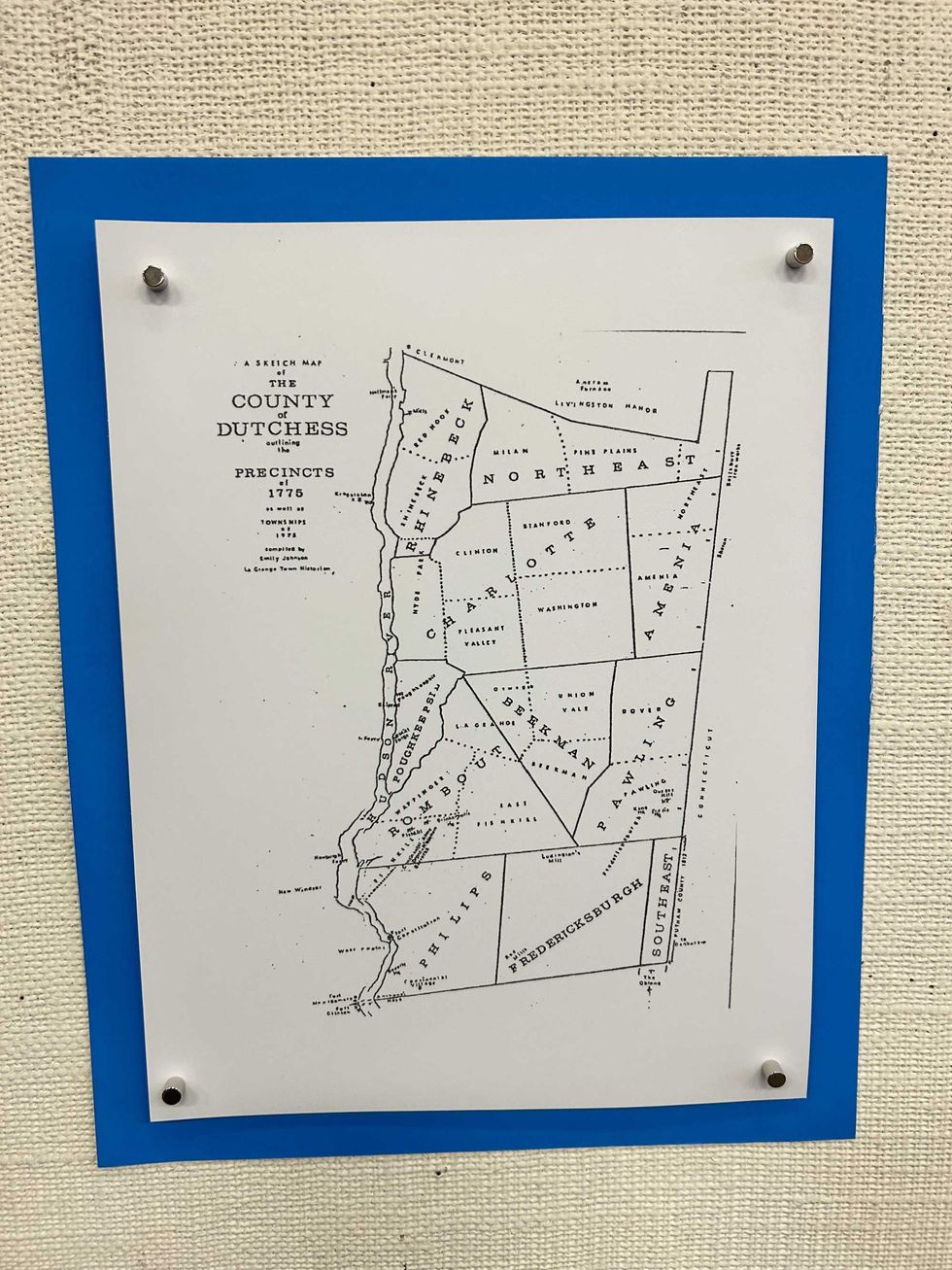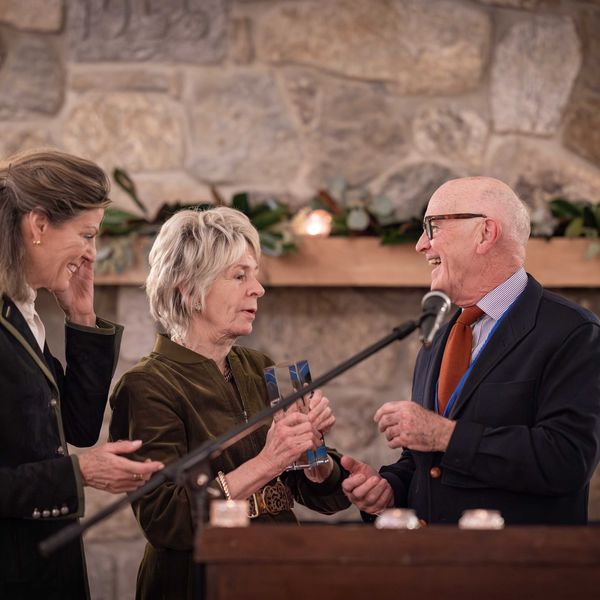Latest News
Rie McCarthy’s ceramics caught the eye of Keavey Bedell at Salisbury Handmade .
Patrick L. Sullivan
SALISBURY — The curious and the driven bustled into the White Hart Saturday, Nov. 29 for the first of two Salisbury Handmade events. Vendors offered a wide range of handmade products that the average holiday shopper is not going to find at a chain store.
Most of the people there were in the curious camp. Keavey Bedell looked casually at Rie McCarthy’s ceramics, and then more closely at a Jizo statue (a small representation of the Buddha). Bedell decided on the larger of the two Jizos.
McCarthy’s wares start around $25 for small bowls suitable for condiments to $35 for minimalist tea cups to larger items like serving bowls. She makes them in her studio in Mt. Washington, Massachusetts, and while she will not be at the second event on Dec. 13, her goods are available in Great Barrington at the Railroad St. Collective at 25 Railroad St. or at RIESMceramics.com.
Ambling around the corner, a reporter found Marilyn Davis of Amesville and her assortment of four-color prints of local scenes such as Lake Wonoscopomuc and Twin Lakes, all nicely framed and eminently affordable at $30 and up.
Davis’ work is available online Etsy under the name “FavoritePlacesArt,” or email mollyhardy2@gmail.com.
Continuing the circuit, the reporter, who was in the “driven” camp and looking for consumable gifts for his mother who does not want any more permanent “stuff,” came across Ani Jenkins of Falls Village, with assorted skin care items and herbal teas, all hand made.

The teas did the trick. After sampling the two on offer, the decision was made to go with the Peace Blend, consisting of chamomile, tulsi,and sitka rose ($16). It’s loose tea— Jenkins is adamantly anti-tea bag — and she had a couple of mason jar infusers for sale as well.
Jenkins either grows or collects these ingredients, sometimes from Alaska, where she and her husband have a summer cabin. She said she has had many interesting conversations with Transportation Safety Administration officials while bringing back Alaskan herbs. See www.umbotanicals.com for more information.
Shaari Horowitz, a veteran of the Salisbury Handmade scene, had her usual array of truly spectacular wooden bowls, decorated in such a way that actually using them as bowls seems unlikely, like putting the Mona Lisa on a couple of sawhorses as an impromptu picnic table.
No such ambiguity exists with Horowitz’ selection of interesting earrings, starting at $45. Horowitz will be on hand on Dec. 13.
As will Karin Gerstel of Undermountain Weavers. This year the weavers feature rugs and blankets made from Sam’s Wool (Sam Waterston is the Sam involved) starting at $150, plus wool beanies that are perfect for winter ($38).
Salisbury Handmade was established about 18 years ago when a number of local artisans banded together after the closing of Creative Hands, a local craft consignment store.
The group began to organize local shows to showcase local artists and their handmade items under several names, including Renegade Artisans Group, Salisbury Artisans Group and Salisbury Handmade.
Salisbury Handmade promotes four shows per year. The one-day spring show happens outdoors on the White Hart lawn in mid-May. The two-day autumn show, also on the lawn, occurs during the Salisbury Fall Festiva, and two one-day holiday shows are hosted inside the Inn.
Salisbury Handmade shares proceeds from the shows with local non-profits. The group also thanks the White Hart for hosting the shows.
Keep ReadingShow less
Cold temperatures pushed the Sneed family into Candy-o’s on Main Street where Tanner Sneed shows off his Grinch face to son William on Friday, Nov. 28.
Photo by Nathan Miller
The Millerton Festival of Lights returned to downtown Friday, Nov. 28, with a full day of holiday activities and treats for kids and families across the village. Paraders capped the night with light-adorned trucks, tractors, trailers and even a bicycle.
Keep ReadingShow less
Rachele Grieco Cole
Photo by Aly Morrissey
MILLERTON — From the Jersey shore to the Taconic Mountains, incoming Democratic Town Board member Rachele Grieco Cole has followed a distinctive path – one that includes living in a seminary, earning a degree in theology and navigating the world of nonprofit grants and fundraising.
In January, she will become the newest member of the Town Board, where she looks forward to contributing in myriad ways – especially when it comes to affordable housing. She hopes to collaborate closely with Councilwoman Meg Winkler, who leads the housing committee and has spearheaded efforts toward Pro-Housing Community status and supported the PlusOne ADU program.
“There are people who are struggling to keep a roof over their heads,” said Grieco Cole. “Whether it’s the ability to age in place or young families trying to put down roots, we need affordable housing and we need to keep talking about it as a board.”
Grieco Cole’s uncontested run this year contrasted sharply with her 2024 campaign, when she sought to fill a one-year vacancy on the board.
Although she lost to Republican Chris Mayville – who also secured an uncontested win this year to retain his seat – Grieco Cole doesn’t view her earlier defeat as a “loss.” The race was tight, and as a newcomer she earned 47% of the vote, giving her name recognition and valuable experience ahead of this election cycle.
“I think I knocked on over 200 doors,” she said. “I met a lot of people and we had good conversations – I feel like they got to know me.”
The 2024 campaign helped her hit the ground running this fall as she canvassed for Democratic candidates for county office. Among the most common concerns she heard from residents were the timeline for the long-awaited grocery store, veterans’ benefits and high vehicle speeds on residential roads.
Grieco Cole plans to bring her extensive background in grant management to the board. She currently manages grants for a New York Law School, a nonprofit law school in New York City, securing funding for social justice and civic engagement initiatives.Over the years, she has developed a nuanced understanding of how communication, trust and relationship building drive successful grantmaking.
“It’s about putting in the time to establish relationships and follow up,” she said, adding that federal grants are “drying up.” Still, she said she isn’t afraid of the work required to achieve results.
Locally, Grieco Cole has helped guide the process for three New York State grants supporting the new short-course Olympic pool at Eddie Collins Memorial Park. “It has been really interesting and exciting and I can’t wait for it to come to fruition,” she said. The village expects to break ground on that project next summer after the July celebration of the Village of Millerton’s 175th anniversary.
Grieco Cole says she and her husband fell instantly in love with Millerton and can’t imagine themselves living anywhere else. Like many residents in the region, they traded in the hustle and bustle of New York City for the slower pace and rural charm of the area. “I love how everyone here has a voice,” she said. “You don’t get that in the city.”
The historic Moviehouse and downtown played a role in their move, and when they found an old house to restore, Grieco Cole said “there was no turning back.”
A regular at town meetings, a volunteer with the new village tree committee and an active patron of Main Street businesses, Grieco Cole wants residents to know she’s invested in Millerton’s future, follows through on commitments and approaches the role with good intentions.
She will soon attend a three-day training session for newly elected town officials. “The agenda is really loaded and I want to absorb as much as I can out the gate,” she said. “It will be a learning curve and I’m looking forward to that.”
Keep ReadingShow less
The NorthEast-Millerton Library's November exhibit featured documents and maps detailing the facts of life in northeast Dutchess County during the revolution.
Photo by Aly Morrissey
MILLERTON — The 250th anniversary of the American Revolution has sparked a renewed interest in the nation’s origins, reflected in a wave of cultural commentary, new books and films like the recently released Ken Burns documentary that examines how the United States began.
While popular historical narratives often glorify famous battlefields and political figures, visitors of the NorthEast-Millerton Library indulged in an exhibit last month that explored how the Revolution unfolded right here in North East among everyday people.
Curated and written by the North East Historical Society — including President Ed Downey and Meg Downey — the exhibit was on view in the library’s main building through November.
“Telling the story of how 250 years ago the American War of Independence affected the people who lived where we live now is very difficult,” the exhibit text began, adding that a devastating 1911 fire destroyed many documents and archives in the New York State Library in Albany. “This disaster incinerated many 18th-century records from Dutchess County.”

Although the North East Historical Society is not in possession of any original documents or archives from the period, the exhibit drew on materials from the Dutchess County Historical Society, the History of Little Nine Partners, surviving 1778 meeting minutes discovered at the Huntington Library in California, and archived articles from The Lakeville Journal and The Millerton News, among other sources.
Everyday families felt the Revolution long before news of battles reached them. The exhibit described its impact as a “relentless stream that built up to a flood,” beginning with steep taxes, religious and political division, and eventually the forcible transfer of land and property. As local men left for battle, women managed farms and raised children alone, navigating fear, scarcity and a community split between Patriots and Loyalists.
A shadow government takes over North East
The miraculous discovery of 1778 meeting minutes from the “Committee on Safety” depicts a group of Patriots who became the de facto local government for what was then known as the Northeast Precinct, an area including the present-day towns of North East, Pine Plains and Milan.
Photographs of the meeting minutes were on display in the exhibit. The document was found in the Huntington Library of California and includes 64 clear, handwritten pages that span 17 meetings. The committee met regularly at the house of James Young in what is now Pine Plains.
“While the meetings begin in calm deliberation, grappling with problems in a seemingly orderly way, toward the end of the record book the pace becomes frenetic,” the introduction notes. The tone of the minutes become “increasingly filled with alarm” and civil unrest, and the meeting frequency increases “almost overnight.”
The committee’s work included collecting food for those in need, handling complaints such as unlicensed liquor sales, and arranging to deport families of Loyalists across enemy lines.
One prominent committee member was Samuel Eggleston IV, who lived in what is now the Town of North East. The exhibit showed his role in collecting and returning grain to support Continental troops. He is buried in Spencer’s Corners Cemetery just north of Millerton.
Local iron ore supported the Patriots
Although the region was “too sparsely settled and too dense with forests to be where armies would travel or territory worth capturing,” it had one critical resource that supported the American cause.
Pits of iron ore in nearby Ancram and surrounding areas helped “feed the blast furnace” in what is now Lakeville, Connecticut, and eventually supported the manufacturing of weaponry, including cannon and musket balls. “The Salisbury Association estimates that the approximately 850 cannons produced represented about three quarters of those made in the colonies,” the exhibit stated.
Places, faces and names
The exhibit was rich with stories, documents and local names — many of which are still recognizable in this region today. Visitors could view the full list of residents who signed, and those who refused to sign, the Patriot pledge — a commitment to reject British authority.
“Signing it would be a death warrant if their cause failed,” the exhibit noted. “But to refuse to sign could engender the hate and distrust of their fellow citizens.” Loyalty in the old Northeast Precinct was far from unanimous, with residents split over which side to support. 298 men signed while 146 declined.
Additionally, photos of local soldiers’ gravestones, records of supply collections and stories passed down through generations painted a picture of how the war shaped daily life in the region.
Keep ReadingShow less
loading















